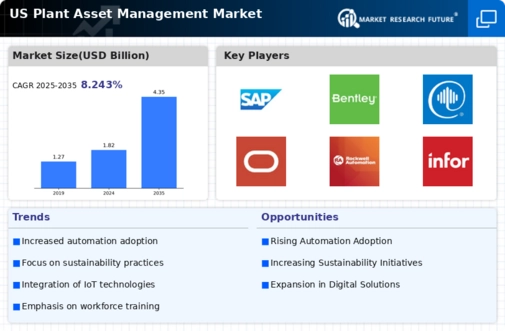Growing Demand for Operational Efficiency
In the plant asset-management market, there is a growing demand for operational efficiency as organizations strive to reduce costs and maximize productivity. Companies are increasingly focusing on streamlining their asset management processes to enhance performance and minimize waste. This trend is reflected in the projected growth of the market, which is expected to reach $10 billion by 2027. The emphasis on operational efficiency is driving investments in modern asset management solutions that facilitate better resource allocation and improve overall asset lifecycle management.
Technological Advancements in Asset Management
the market is experiencing a surge in technological advancements that enhance operational efficiency. Innovations such as advanced analytics, artificial intelligence, and machine learning are being integrated into asset management systems. These technologies enable organizations to optimize asset performance and reduce downtime. According to recent data, the adoption of these technologies is projected to increase by 25% over the next five years. This trend indicates a shift towards more data-driven decision-making processes within the plant asset-management market, allowing companies to leverage real-time data for improved asset utilization and maintenance strategies.
Rising Importance of Data Security and Compliance
Data security and compliance are becoming increasingly critical in the plant asset-management market. With the growing reliance on digital systems, organizations must ensure that their asset management practices adhere to regulatory standards and protect sensitive information. The market is responding to this need by implementing robust cybersecurity measures and compliance protocols. This trend is expected to drive investments in secure asset management solutions, as companies seek to mitigate risks associated with data breaches and regulatory violations, thereby enhancing their operational integrity.
Shift Towards Sustainable Asset Management Practices
the market is experiencing a shift towards sustainable asset management practices. Organizations are increasingly recognizing the importance of sustainability in their operations, leading to the adoption of eco-friendly asset management strategies. This trend is reflected in the growing number of companies that are implementing practices aimed at reducing their environmental footprint. The market is projected to grow as businesses seek to align their asset management processes with sustainability goals, potentially leading to a 15% increase in demand for green technologies and practices in the coming years.
Increased Focus on Workforce Training and Development
the market is witnessing an increased focus on workforce training and development. As technologies evolve, organizations recognize the need for skilled personnel who can effectively manage and maintain advanced asset management systems. This emphasis on training is crucial for maximizing the benefits of new technologies and ensuring that employees are equipped to handle complex asset management tasks. Companies are investing in training programs, which is likely to enhance workforce capabilities and improve overall asset performance in the plant asset-management market.

























Leave a Comment